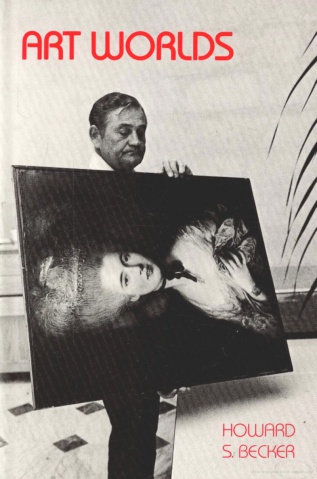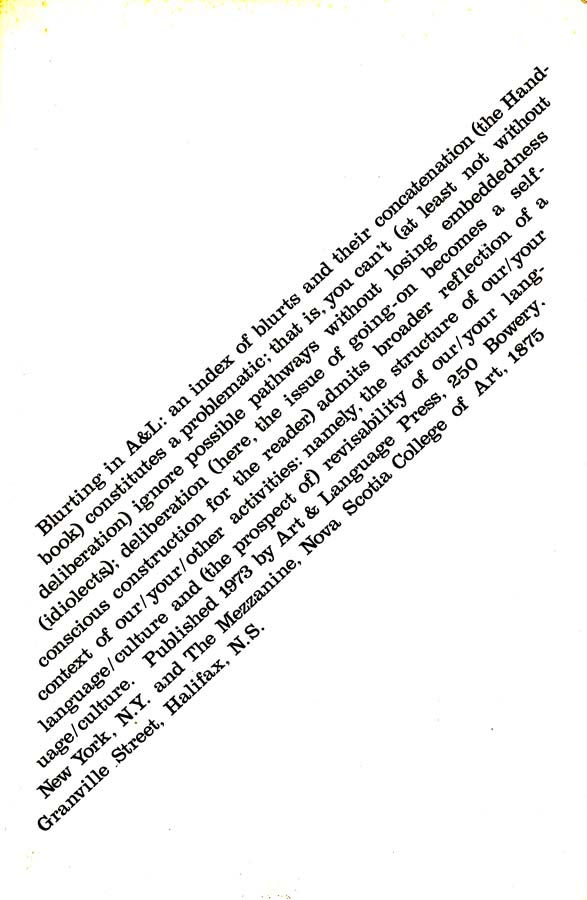Howard S. Becker: Art Worlds (1982)
Filed under book | Tags: · aesthetics, art, art criticism, art history, art system, sociology of art

This classic sociological examination of art as collective action explores the cooperative network of suppliers, performers, dealers, critics, and consumers who—along with the artist—”produce” a work of art. Howard S. Becker looks at the conventions essential to this operation and, prospectively, at the extent to which art is shaped by this collective activity. He draws examples from music, drama, dance, literature, film, and the visual arts.
“Maybe the years I spent playing the piano in taverns in Chicago and elsewhere led me to believe that the people who did that mundane work were as important to an understanding of art as the better-known players who produced the recognized classics of jazz. Growing up [..] may have led me to think that the craftsman who help make art works areas important as the people who conceive them. My rebellious temperament may be the cause of a congenital antielitism. Learning the ‘Chicago tradition’ of sociology from Everett C. Hughes and Herbert Blumer surely led to a skepticism about conventional definitions of the objects of sociological study.” (from Preface)
Publisher University of California Press, 1982
ISBN 0520043863, 9780520043862
392 pages
via drebubbles
Review: Michael S. Kimmel (American Journal of Sociology, 1983)
PDF (44 MB, updated to OCR’d version on 2014-2-17 via Marcell Mars)
Comment (1)Blurting in A & L [Art & Language] (1973/2002) [English/German]
Filed under book | Tags: · ambiguity, anthropology, art, art criticism, art system, autonomy, conceptual art, experience, ideology, knowledge, language, learning, mapping, philosophy, theory, translation, work

Blurting in A & L is a printed booklet whose content is a dictionary with blurts or ‘annotations’. The annotations were written by the members of Art & Language Ian Burn, Michael Corris, Preston Heller, Joseph Kosuth, Andrew Menard, Mel Ramsden and Terry Smith.
“The project began as a collaboration among Art & Language members in New York City. In weekly meetings from January to July 1973, eight participants produced written statements called ‘annotations’ or ‘blurts’ on topics ranging from the ordinary to the abstruse (art, learning, ambiguity, heuristics, stimulus-meaning). In each subsequent meeting the group would return with new statements that ‘went on’ from the last week’s annotations. In the end, through the efforts of Michael Corris and Mel Ramsden the comments were compiled in a handbook. In all, some 400 odd entries were edited and grouped according to subheadings with vague quasi-logical connectors linking them to one another.
Since the connections among the entries were many-to-many, readers could choose their own course through the material, which blurred the boundary between passive reader and active participant. This was a key ideology of Art & Language – the idea that membership was permeable or, as one participant put it, ‘a function of participation’.” (from a commentary by Chris Gilbert, Mute, 2002)
An online version installed by ZKM, Karlsruhe, in 2002 includes articles which contextualize Blurting in A & L within the activities of the group in the 1970s. Present and former members of Art & Language (Michael Baldwin, Michael Corris, Philip Pilkington, Mel Ramsden) summarize and reflect on their activities. Thomas Dreher embeds Blurting in A & L within the proceedings of the discourse of Art & Language.
Blurting in A&L: An Index of Blurts and Their Concatenation (the Handbook) Constitutes a Problematic; That Is, You Can’t (at Least Not Without Deliberation) Ignore Possible Pathways Without Losing Embeddedness (Ideolects); Deliberation (Here, the Issue of Going-On Becomes a Self-Conscious Construction for the Reader) Admits Broader Reflection of a Context of Our/Your/Other Activities: Namely, the Structure of Our/Your Language/Culture and (the Prospect of) Revisability of Our/Your Language/Culture
Edited by Michael Corris, Mel Ramsden
Publisher Art & Language Press, New York, and The Mezzanine, Nova Scotia College of Art, Halifax, 1973
92 pages
Online version and accompanying publication edited by Thomas Dreher, 2002.
Announcement of the hypertext version (Syndicate, 2002)
Blurting in A & L (1973, HTML)
Blurting in A & L Online (English, 2002, HTML)
Blurting in A & L Online (German, 2002, HTML)
Linda M. Montano (ed.): Performance Artists Talking in the Eighties: Sex, Food, Money/Fame, Ritual/Death (2000)
Filed under book | Tags: · 1980s, art, art history, art system, feminism, food, performance, performance art, religion, sexuality, video art

“Performance artist Linda Montano, curious about the influence childhood experience has on adult work, invited other performance artists to consider how early events associated with sex, food, money/fame, or death/ritual resurfaced in their later work. The result is an original and compelling talking performance that documents the production of art in an important and often misunderstood community.
Among the more than 100 artists Montano interviewed from 1979 to 1989 were John Cage, Suzanne Lacy, Faith Ringgold, Dick Higgins, Annie Sprinkle, Allan Kaprow, Meredith Monk, Eric Bogosian, Adrian Piper, Karen Finley, and Kim Jones. Her discussions with them focused on the relationship between art and life, history and memory, the individual and society, and the potential for individual and social change. The interviews highlight complex issues in performance art, including the role of identity in performer-audience relationships and art as an exploration of everyday conventions rather than a demonstration of virtuosity.”
Publisher University of California Press, 2000
ISBN 0520210220, 9780520210226
537 pages

